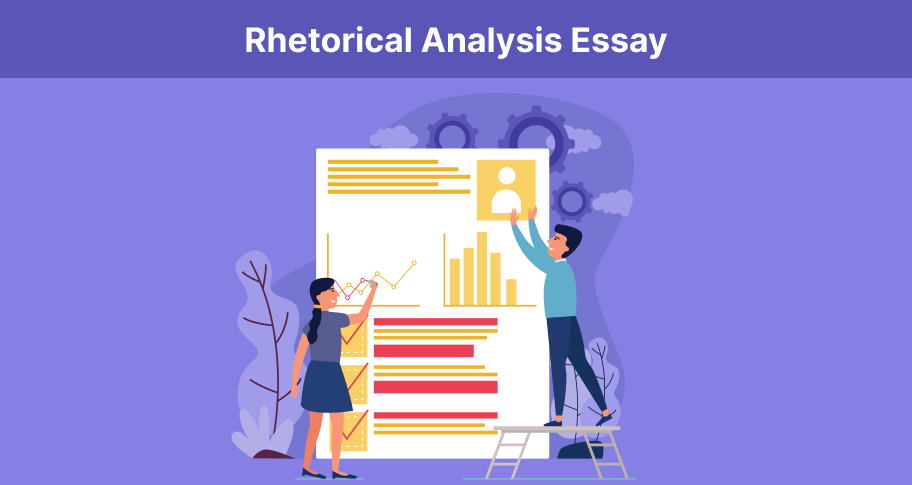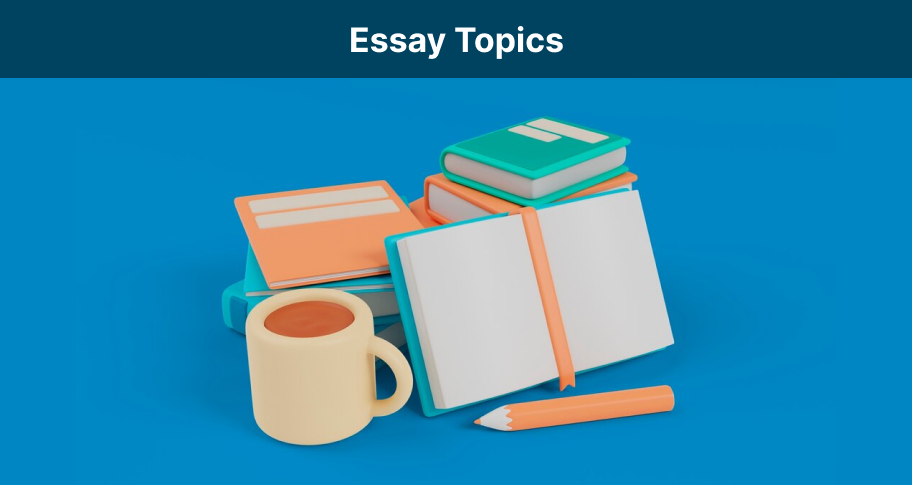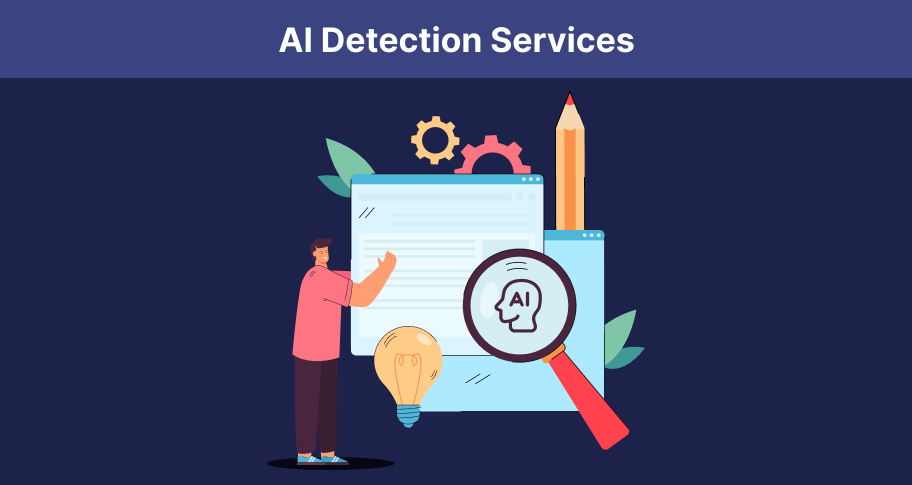Introduction
Want to know how to write a rhetorical analysis essay that impresses? You have to understand the power of persuasion. The power of persuasion lies in the ability to influence others’ thoughts, feelings, or actions through effective communication. In everyday life, it plays a crucial role in shaping opinions, making decisions, and driving actions. Whether in personal relationships, professional settings, or public discourse, persuasion helps individuals advocate for their ideas, negotiate solutions, and motivate others toward desired outcomes. Mastering persuasion can enhance leadership, improve negotiation skills, and foster better interpersonal connections.
A rhetorical analysis essay examines how an author or speaker uses language and rhetorical strategies to persuade their audience. The purpose of this type of essay is to analyze the effectiveness of these techniques in achieving the author’s goals. This involves looking at various elements, such as the use of ethos (credibility), pathos (emotional appeal), and logos (logical arguments), as well as the author’s style, tone, and structure. By understanding how these elements work together to influence the audience, the essay provides insight into the power and impact of the author’s message.
Understanding rhetorical strategies is valuable for several reasons: critical thinking, effective communication, enhanced persuasion, improved audience awareness, and analytical skills. Rhetoric enhances your ability to analyze and evaluate arguments. By recognizing how persuasive techniques are used, you can better assess the strengths and weaknesses of different viewpoints and arguments.
Knowing rhetorical strategies helps you craft your own arguments more persuasively. Whether writing, speaking, or engaging in debate, you can use these strategies to connect with your audience and convey your message more compellingly.
Understanding these strategies allows you to influence others more effectively. By applying appropriate rhetorical techniques, you can better achieve your goals in personal, professional, and public contexts.
Rhetoric helps you tailor your message to the needs and preferences of your audience. By understanding what appeals to different audiences, you can adjust your communication to be more effective. It also develops your ability to dissect complex texts and speeches, leading to a deeper comprehension of both the content and its delivery. This skill is beneficial in both academic and everyday contexts. Overall, mastering rhetorical strategies equips you with the tools to both critically evaluate and create persuasive messages.
In this article, we will examine the various elements of a rhetorical analysis essay. We will start by understanding the basics of rhetoric, cover the steps to writing a rhetorical essay, provide an example essay, and finish with tips.
Understanding the Basics of Rhetoric
Before you can write a rhetorical analysis essay, you have to start by defining rhetoric. Rhetoric is the art of persuasion through effective communication. It involves using language strategically to influence, convince, or inform an audience. Rhetoric aims to achieve a specific goal, such as persuading an audience to adopt a particular viewpoint, take action, or understand a concept. Effective rhetoric takes into account the audience’s needs, values, and emotions. Understanding your audience helps tailor your message to resonate with them.
Rhetoric uses ethos, pathos, and logos to persuade. Ethos establishes credibility and trustworthiness. It involves demonstrating authority or expertise on the topic. Pathos appeals to the audience’s emotions, aiming to connect on an emotional level and create a response. Logos uses logical arguments and evidence to persuade through reason and rationality.
Rhetoric also involves choosing the right style and delivery methods. This includes the use of language, tone, structure, and persuasive techniques to convey the message effectively. The effectiveness of rhetoric often depends on the context in which it is delivered, including cultural, social, and situational factors. Overall, rhetoric is a crucial skill in various fields, including politics, business, and personal communication, as it enables individuals to influence and engage others through their use of language effectively.
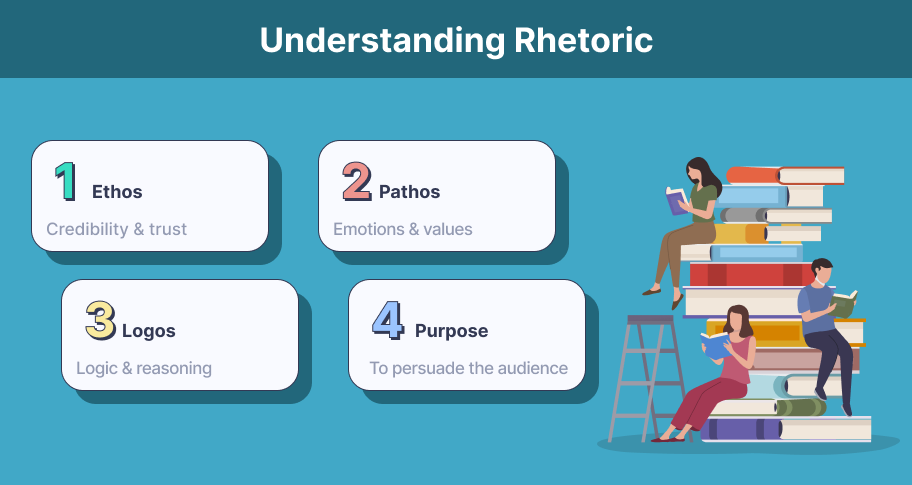
The Rhetorical Situation
The rhetorical situation encompasses the various elements that define and shape the act of communication. Understanding these elements helps in crafting compelling messages and analyzing how they work.
The speaker or writer is the individual or entity delivering the message. This can be a person, a group, or an organization. The speaker’s credibility, background, and perspective play a significant role in how the message is received. Understanding the speaker’s ethos, or their character and authority on the subject, is crucial for evaluating their arguments.
The audience is the recipients or target of the message. The audience includes the individuals or groups who will read, listen to, or view the communication. Knowing the audience’s characteristics, such as their interests, values, and prior knowledge, helps tailor the message to effectively reach and engage them. Audience analysis helps predict how the message will be perceived and how to address potential objections or questions.
The purpose is the goal or intention behind the communication. The purpose defines what the speaker or writer aims to achieve with the message. This could be to persuade, inform, entertain, or motivate the audience. Clearly defining the purpose helps in structuring the message and focusing on the key points that need to be communicated. The effectiveness of the communication often hinges on how well the purpose aligns with the audience’s needs and expectations.
The context is the surrounding environment or situation in which the communication occurs. Context includes the time, place, cultural, social, and situational factors that influence the message. It can affect both the content and delivery of the communication. For instance, a message delivered during a political campaign may have different implications than the same message delivered in a casual social setting. Understanding the context helps in addressing relevant issues and ensuring the message is appropriate and effective for the given situation.
By analyzing these elements, you can gain a deeper understanding of how effective communication operates and how to craft messages that are appropriate for specific situations and audiences.

The Rhetorical Triangle (Ethos, Pathos, Logos)
The rhetorical triangle consists of three key elements—ethos, pathos, and logos—that work together to create persuasive and effective communication.
Ethos refers to the credibility and ethical appeal of the speaker or writer. Establishing ethos involves demonstrating expertise, reliability, and trustworthiness. It’s about convincing the audience that the speaker or writer is knowledgeable and has a good character, making them credible sources on the topic. Ethos can be established through:
-
- Professional Experience: Showcasing relevant qualifications or experience.
- Reputation: Leveraging a solid reputation or previous successes.
- Tone and Presentation: Using a respectful and professional tone and presenting information clearly and accurately.
- Alignment with Values: Connecting with the audience’s values and beliefs to build trust.
Pathos refers to the emotional appeal used to persuade the audience. Pathos involves tapping into the audience’s emotions to create a connection and influence their attitudes or decisions. By evoking feelings such as sympathy, anger, joy, or fear, the communicator can make the message more compelling and memorable. Techniques for using pathos include:
-
- Anecdotes: Sharing personal stories or testimonials that resonate emotionally.
- Imagery: Using vivid language and imagery to evoke specific feelings.
- Emotional Language: Employing words and phrases that elicit emotional responses.
Logos refers to the logical appeal based on reason and evidence. Logos involves using logical arguments, facts, statistics, and reasoning to persuade the audience. It’s about presenting a well-structured argument supported by evidence that appeals to the audience’s rationality. Effective use of logos includes:
-
- Evidence: Providing concrete data, examples, and facts.
- Reasoning: Using clear, rational arguments and logical connections.
- Clarity: Presenting information in a coherent and organized manner to facilitate understanding.
The rhetorical triangle demonstrates how ethos, pathos, and logos interact to create persuasive messages. Ethos builds credibility, pathos appeals to emotions, and logos relies on logic and evidence. Effective communication often involves balancing all three elements to engage the audience and achieve the desired outcome.
Rhetorical Devices and Strategies
Writers use various rhetorical devices in essays and strategies to help persuade their audience. Understanding these devices is critical when you want to write an effective rhetorical analysis essay because you need to be able to recognize them and analyze them in your source material.
A metaphor is a figure of speech that compares two unlike things by stating one is the other, suggesting a similarity between them. “Time is a thief” is an example of a metaphor. Metaphors help make abstract concepts more concrete and relatable, enhancing understanding and emotional impact.
A simile is a figure of speech that compares two unlike things using “like” or “as.” “Her smile was like sunshine” is an example of a simile. Similes clarify ideas and evoke imagery, making arguments more vivid and engaging.
Repetition refers to the intentional repetition of words or phrases to emphasize a point or theme. One of the most famous examples of repetition is in Dr. King’s I Have a Dream speech. Repetition reinforces vital messages, making them more memorable and persuasive.
Alliteration is the repetition of the same initial consonant sound in words that are closely positioned. Many tongue-twisters feature repetition, like “Peter Piper picked a peck of pickled peppers.” Alliteration adds rhythm and emphasis, making phrases catchier and more engaging.
Hyperbole is an exaggerated statement that is not meant to be taken literally; it is used for emphasis. “I’ve told you a million times” is a hyperbole parents often use with their children. Hyperbole draws attention to critical points and conveys strong emotions or urgency.
The opposite of hyperbole is an understatement, which is deliberately downplaying the significance of something. “It’s just a small scratch” (when referring to a significant dent) is an example. Understatement can draw attention to the magnitude of an issue by minimizing it, often adding a layer of irony or emphasis.
An analogy is a comparison between two things that are alike in some respects, often used to explain or clarify. An example of an analogy is, “Just as a sword is the weapon of a warrior, a pen is the weapon of a writer.” Analogies help clarify complex ideas by relating them to familiar concepts, making arguments more understandable and persuasive.
Many writers use rhetorical questions, which are questions that they ask to make a point rather than to seek an answer. A politician asking, “Isn’t it time for a change?” is not seeking an answer but trying to encourage people to vote for them. Rhetorical questions engage the audience and prompt them to think about the issue, reinforcing the speaker’s position.
Irony is one of this writer’s favorite rhetorical tools. It refers to a contrast between expectation and reality, often used to highlight discrepancies. A fire station burning down is an example of irony. O’Henry’s short stories are some of the best examples of irony available. Irony can highlight contradictions or absurdities, adding humor or emphasizing a point.
The opposite of hyperbole is an understatement, which is deliberately downplaying the significance of something. “It’s just a small scratch” (when referring to a significant dent) is an example. Understatement can draw attention to the magnitude of an issue by minimizing it, often adding a layer of irony or emphasis.
It is essential not to overlook the role that pathos plays as a rhetorical tool. An emotional appeal uses emotions to persuade. Pathos creates an emotional connection, influencing the audience’s feelings and responses.
Devices like metaphors and similes clarify complex ideas by drawing comparisons to familiar concepts. Repetition, alliteration, and rhetorical questions make messages more engaging and memorable. Hyperbole, pathos, and irony tap into emotions, making the argument more compelling and relatable. Analogies and rhetorical questions encourage deeper thinking and reinforce the speaker’s position. By incorporating these rhetorical devices, communicators can effectively persuade their audience, making their arguments more impactful and engaging.
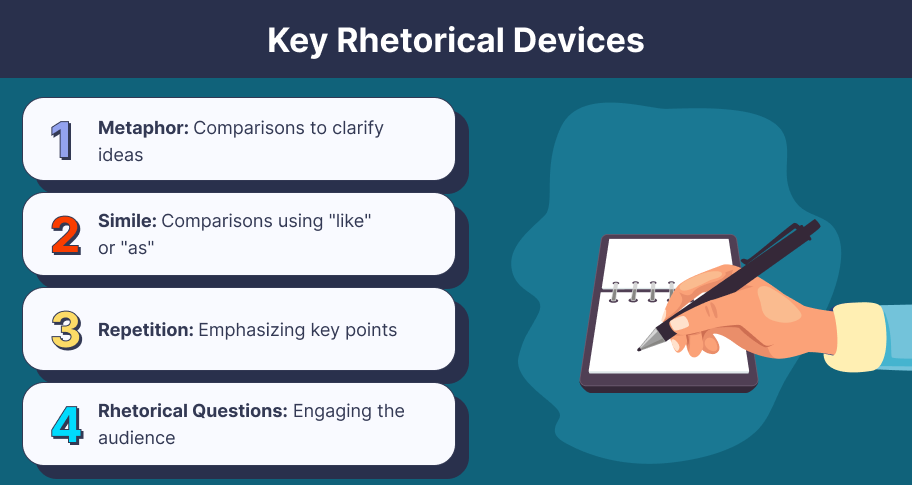
Steps to Writing a Rhetorical Analysis Essay
1. Choose a Suitable Text
Selecting a text rich in rhetorical devices is crucial when writing a rhetorical analysis essay. It offers substantial material for analysis, lets you highlight the author’s skill, provides clear examples of various rhetorical strategies, enhances critical thinking, engages the reader, and strengthens argumentation.
A text with numerous rhetorical devices offers a wealth of material for analysis. This variety allows for a more comprehensive examination of how different strategies contribute to the effectiveness of the text. It enables you to explore how various devices interplay to persuade or engage the audience.
Analyzing a text rich in rhetorical devices highlights the author’s skill in crafting their message. It provides insight into how deliberate choices in language and structure enhance the overall persuasive impact. This can reveal the author’s intent and the nuances of their argument.
A text rich in rhetorical devices allows you to clearly demonstrate how specific strategies—such as ethos, pathos, and logos—are employed. It shows how the author builds credibility, appeals to emotions, and uses logical arguments to persuade their audience.
With a variety of rhetorical devices, you can offer concrete examples to support your analysis. This strengthens your argument by showing how the author’s use of devices directly impacts the effectiveness of the text.
Analyzing a text with rich rhetorical devices challenges you to think critically about the author’s techniques. It encourages a deeper understanding of how language influences perception and how different strategies can be used to achieve specific effects.
A text with engaging rhetorical devices is more likely to captivate your interest and that of your readers. This engagement can make your analysis more compelling and insightful as you are more invested in examining how the text works.
When a text is rich in rhetorical devices, it provides multiple angles for discussing how the author’s choices contribute to their argument. This can help you build a more nuanced and robust analysis, making your essay more effective.
Selecting a text rich in rhetorical devices is essential for writing a thorough and insightful rhetorical analysis essay. It offers diverse examples and strategies to explore, enhances your ability to demonstrate how the text persuades its audience and enriches your analysis by revealing the intricacies of rhetorical craftsmanship.
Here are some examples of suitable texts for rhetorical analysis essays across various genres:
Speeches
- “I Have a Dream” by Martin Luther King Jr.: A powerful speech addressing racial injustice and promoting equality, rich in rhetorical devices like metaphors, repetition, and pathos.
- “The Gettysburg Address” by Abraham Lincoln: Known for its use of ethos, logos, and pathos to unify and inspire a nation during the Civil War.
Advertisements
- Apple’s “Think Different” Campaign: Features persuasive techniques such as ethos and pathos to position Apple as innovative and revolutionary.
- Nike’s “Just Do It” Campaign: Uses ethos and pathos to create a motivational and empowering brand image.
Essays
- “Letter from Birmingham Jail” by Martin Luther King Jr.: A compelling essay that uses logos, ethos, and pathos to argue against racial segregation and injustice.
- “A Modest Proposal” by Jonathan Swift employs satire and irony to critique British policy towards the Irish, which is rich in rhetorical devices.
Editorials
- Op-eds from The New York Times or The Guardian: These pieces often use rhetorical strategies to argue for or against specific policies or issues, providing ample material for analysis.
- “The Case for Reparations” by Ta-Nehisi Coates: Uses historical examples and emotional appeals to argue for reparations for African Americans.
Political Cartoons
- Political cartoons by artists like Gary Trudeau or Thomas Nast: Utilize visual rhetoric and satire to comment on political and social issues.
Literary Works
- “The Great Gatsby” by F. Scott Fitzgerald: Rich in metaphor, symbolism, and rhetorical style, particularly in the character of Gatsby and the narrative’s social commentary.
- “Pride and Prejudice” by Jane Austen Offers examples of irony and social critique through its characters and plot.
Media Clips
- TED Talks: Various TED Talks feature robust rhetorical strategies in addressing diverse topics, such as Simon Sinek’s “How Great Leaders Inspire Action.”
- Political Campaign Ads: Political campaign ads often use rhetoric to persuade voters, making them suitable for analysis.
Public Service Announcements (PSAs)
- “This Is Your Brain on Drugs” Campaign: Uses emotional appeals and stark imagery to discourage drug use.
- “Dove Real Beauty” Campaign: Employs pathos and ethos to promote body positivity and self-esteem.
These texts are ideal for rhetorical analysis as they provide rich examples of how language, imagery, and structure can be used to persuade, inform, or entertain. They each offer different angles for examining rhetorical strategies and their effectiveness.
2. Carefully Read and Analyze the Text
-
- Active Reading
It is essential to start with active reading. While reading the text, you want to be able to answer the following questions:
-
-
- What is the author’s main argument or message?
- Who is the intended audience?
- What rhetorical appeals are used?
- What rhetorical devices are employed?
- How effective is the author’s use of rhetoric?
-
You can use active reading to answer those questions. Active reading is an engaged and purposeful approach to reading that involves interacting with the text to enhance understanding and retention. Unlike passive reading, where one merely reads through the material, active reading requires the reader to engage with the content actively.
Skim the headings, subheadings, and introductory paragraphs to get an overview of the main ideas and structure. This will help you identify key terms and concepts that might be important.
Ask questions about the text before, during, and after reading to clarify understanding and maintain focus. Formulate questions such as “What is the author’s purpose?” or “What evidence supports this argument?”
Annotate in order to answer those questions. Highlight or underline important points and key details. Make notes in the margins to summarize information, jot down questions, or highlight significant points. After you finish a section, summarize it—paraphrase sections of the text in your own words to ensure comprehension. Write summaries of paragraphs or sections to capture the main ideas.
Once you have finished reading, think critically about the text’s arguments, biases, and implications. Consider the author’s purpose and whether the evidence supports their claims. Was the author effective at accomplishing their goals?
Active reading is particularly useful for academic study, professional development, and any context where deep comprehension and critical analysis are essential.
3. Develop a Strong Thesis Statement
A thesis statement is a concise summary of the main point or claim of a paper. It is typically one to two sentences long and clearly articulates the central argument or interpretation that the writer intends to support throughout the essay. In a rhetorical analysis essay, the thesis statement plays a crucial role in guiding the direction and focus of the analysis.
The rhetorical analysis essay thesis statement outlines the specific rhetorical strategies or elements of the text that will be analyzed. For example, it might focus on how the author uses ethos, pathos, and logos to persuade the audience.
It also guides the argument and sets the direction. It presents the central argument or interpretation regarding how effectively the author uses rhetorical techniques to achieve their purpose. The thesis statement helps organize the analysis by indicating which aspects of the rhetorical situation (such as the speaker’s credibility, emotional appeals, or logical arguments) will be examined.
The thesis provides a roadmap to your essay and frames the discussion. It often hints at the main points or sections of the essay, guiding readers on what to expect in the analysis. For instance, a thesis might indicate that the essay will explore how the speaker’s credibility (ethos), emotional appeals (pathos), and logical arguments (logos) contribute to the overall persuasiveness of the text. It serves as the foundation for the analysis, helping to ensure that each section of the essay supports and develops the central argument or claim made in the thesis.
Your thesis statement also needs to engage the reader so that they keep reading. A strong thesis statement presents a clear and intriguing argument that captures the reader’s attention and encourages them to read further.
Looking at an example of a thesis statement of a rhetorical analysis essay, we can break down its elements:
“In his speech, Martin Luther King Jr. effectively uses emotional appeals (pathos), ethical arguments (ethos), and logical reasoning (logos) to persuade his audience of the necessity of civil rights reform, demonstrating how a powerful rhetorical strategy can mobilize public support and drive social change.”
In this example, the thesis specifies that the essay will analyze how King uses emotional appeals, credibility, and logical arguments. It outlines the main areas of focus for the analysis. It provides a preview of what the reader can expect in the essay.
Overall, the thesis statement is a critical component of a rhetorical analysis essay. It provides a clear and focused argument that guides the analysis of how the author’s rhetorical choices influence their audience.
Examples:
“In Apple’s ‘Think Different’ advertising campaign, the use of minimalist design and inspirational messaging (ethos and pathos) combined with the logical positioning of Apple as a symbol of innovation (logos) effectively rebrands the company as a leader in creativity and individuality, showcasing how branding strategies can influence consumer perception and loyalty.”
This thesis examines the use of design and messaging in advertising, focusing on how these elements create credibility, evoke emotions, and present logical arguments to enhance brand identity.
“In his editorial ‘The Case for Climate Action,’ Bill McKibben utilizes compelling statistics and scientific evidence (logos), personal anecdotes about environmental impact (pathos), and his established expertise in environmental issues (ethos) to persuade readers of the urgent need for climate change intervention, illustrating the power of combining empirical data with emotional and ethical appeals to drive public action.”
The thesis statement addresses McKibben’s use of data, personal stories, and credibility, aiming to analyze how these rhetorical strategies contribute to his persuasive argument about climate action.
4. Create a Detailed Outline
Organization is crucial in a rhetorical analysis essay outline because it ensures a clear, logical, and coherent presentation of your analysis. Effective organization matters. A well-organized essay outline helps you present your thesis and main points clearly, guiding readers through your analysis. It ensures that each part of your essay builds upon the previous one, reinforcing your argument.
Organizing your essay into distinct sections—such as introduction, analysis of rhetorical strategies, and conclusion—helps maintain a logical flow. It allows you to systematically examine how the author’s rhetorical choices contribute to their argument or purpose. An outline helps you stay focused on the specific rhetorical devices and strategies you plan to analyze. By breaking down your essay into sections, you can ensure that each rhetorical element is addressed in detail without deviating from your main argument.
With a structured outline, you can write more efficiently, as you have a clear roadmap to follow. It reduces the likelihood of writer’s block and helps you organize your thoughts before drafting. A well-organized outline contributes to the overall coherence and unity of your essay. It ensures that your analysis is consistent and that all points are relevant to your thesis, creating a more persuasive and compelling argument.
Finally, an outline allows for easier revision, as you can adjust the structure and flow of your argument before committing to the entire draft. This makes it simpler to identify and address any gaps or weaknesses in your analysis.
Effective organization in an outline is essential for crafting a clear, logical, and focused rhetorical analysis essay. It ensures that your argument is presented coherently and that each part of your analysis contributes to your overall thesis.
Here’s a sample outline form for a rhetorical analysis essay, which you can adapt to fit the specific text and rhetorical strategies you’re analyzing:
I. Introduction
A. Hook: Engage the reader with an exciting opening statement related to the text or its rhetorical elements.
B. Background Information: Provide brief context about the text, including its author, title, and purpose.
C. Thesis Statement: State the central argument of your analysis, outlining how the author’s rhetorical strategies achieve their purpose.
II. Summary of the Text
A. Overview: Summarize the main points or arguments of the text.
B. Purpose: Describe the primary goal or purpose of the text.
III. Analysis of Rhetorical Strategies
A. Ethos (Credibility)
1. Explanation: Define how the author establishes credibility or authority.
2. Evidence: Provide examples from the text that demonstrate the use of ethos.
3. Analysis: Discuss the effectiveness of these strategies in persuading the audience.
B. Pathos (Emotional Appeal)
1. Explanation: Define how the author appeals to the emotions of the audience.
2. Evidence: Provide examples from the text that demonstrate the use of pathos.
3. Analysis: Discuss the impact of these emotional appeals on the audience’s response.
C. Logos (Logical Appeal)
1. Explanation: Define how the author uses logic and reasoning to persuade the audience.
2. Evidence: Provide examples from the text that demonstrate the use of logos.
3. Analysis: Evaluate the effectiveness of these logical arguments in supporting the author’s purpose.
D. Additional Rhetorical Devices
1. Device 1 (e.g., Metaphor) – Explanation: Define the rhetorical device. – Evidence: Provide examples from the text. – Analysis: Assess the role and effectiveness of the device in the text.
2. Device 2 (e.g., Repetition) – Explanation: Define the rhetorical device. – Evidence: Provide examples from the text. – Analysis: Evaluate the impact of this device on the overall argument.
IV. Evaluation of Overall Effectiveness
A. Integration of Strategies: Discuss how the author’s use of ethos, pathos, logos, and other rhetorical devices work together to achieve their purpose.
B. Audience Impact: Analyze how these strategies affect the intended audience and contribute to the text’s overall effectiveness.
V. Conclusion
A. Restate Thesis: Summarize how the rhetorical strategies analyzed support the thesis.
B. Summary of Main Points: Recap the key findings from your analysis.
C. Significance: Discuss the importance of understanding these rhetorical strategies in the context of the text and its broader implications.
This outline provides a structured approach to analyzing the rhetorical elements of a text, ensuring that your essay is clear, focused, and well-organized. Adjust the sections as needed based on the specific text and your analysis.
5. Write the Essay
Introduction
Writing a rhetorical analysis essay introduction involves setting up the context for your analysis, introducing the text, and presenting your thesis statement. Here’s a step-by-step guide on how to craft a practical introduction. Start with a hook to capture the reader’s interest and set the stage for your analysis. Provide context by giving the reader background information on the text you will analyze. Include the full title of the text. Mention the author’s name and any relevant background that enhances understanding. Briefly note when and where the text was published, if relevant. Explain the circumstances under which the text was created (e.g., historical context, intended audience).
You want to summarize the text. Remember, a summary is a concise overview of the main argument or message of the text. Highlight the key arguments or themes of the text and describe what the author aims to achieve with the text (e.g., to persuade, inform, entertain). You do not need to go into detail in the summary because you will go into detail in the body of your essay.
Your summary needs to introduce the rhetorical analysis. Then, it leads to the specific aspects of the text that will be analyzed. Mention the main rhetorical strategies or devices that will be discussed (e.g., ethos, pathos, logos). The essay will analyze how these strategies contribute to the text’s effectiveness.
Finally, present your thesis statement. This should be the last sentence of two of your introduction. Clearly state the central argument of your essay. Summarize how the rhetorical strategies are used to achieve the author’s purpose. Briefly mention the critical points of your analysis (e.g., how ethos, pathos, and logos are employed).
Body Paragraphs
In a standard five-paragraph essay, you will have three body paragraphs. Each of those paragraphs should focus on one of the three points in the triangle—ethos, pathos, and logos. It does not matter which order you address them, but you need to address all three of them.
One body paragraph should focus on ethos or credibility. Define how the author establishes credibility or authority. Provide examples from the text that demonstrate the use of ethos. Discuss the effectiveness of these strategies in persuading the audience.
One body paragraph should focus on pathos or emotional appeal. Define how the author appeals to the emotions of the audience. Provide examples from the text that demonstrate the use of pathos. Discuss the impact of these emotional appeals on the audience’s response.
One body paragraph should focus on logos or logical appeal. Define how the author uses logic and reasoning to persuade the audience. Provide examples from the text that demonstrate the use of logos. Evaluate the effectiveness of these logical arguments in supporting the author’s purpose.
Conclusion
Writing a rhetorical analysis essay conclusion involves summarizing your analysis, reflecting on its significance, and reinforcing your thesis. Start with restating your thesis. Remind the reader of your main argument and how the rhetorical strategies support it. Paraphrase your thesis statement, summarizing the key points of your analysis.
Next, summarize the key points of the essay. Briefly review the main rhetorical strategies and their effects, reinforcing how they contribute to the effectiveness of the text. Highlight the significant rhetorical devices and strategies discussed in your essay and how they functioned to achieve the author’s purpose.
It is not enough to summarize; you also need to reflect on the significance of those points. Explain the broader implications of your analysis and the text’s impact on its audience. Discuss how the rhetorical strategies enhanced or diminished the overall effectiveness of the text. Reflect on how the text’s rhetorical choices affected its intended audience or contributed to its persuasive power.
Ideally, you want to use your conclusion to go beyond the text of your essay. Connect your analysis to more prominent themes or contemporary relevance. Discuss how the rhetorical strategies used in the text can be applied to other contexts or texts. If relevant, mention how understanding these strategies can be helpful in today’s media and communication landscape.
Finally, you want to close with a solid final thought. Leave the reader with a memorable insight or reflection related to the text and your analysis. Offer a final observation that ties back to your analysis. Encourage further thought or action based on the insights from your essay.
Revise and Edit
Proofreading and revising are crucial steps in the writing process because they ensure that your work is clear, accurate, and effective.
Proofreading helps identify and correct typographical, grammatical, and spelling errors that could undermine your credibility or confuse your readers. It ensures consistency in style, formatting, and terminology throughout the document, which is essential for professionalism and readability. By reviewing your work, you can spot and fix awkward phrasing or unclear sentences, improving overall clarity and comprehension.
There is no reason you should ever turn in a document with clarity, grammar, or punctuation errors. You can use tools online to check for these errors, and turning in an unchecked paper looks lazy.
Revising allows you to refine your arguments, enhance your ideas, and ensure that your writing effectively communicates your intended message. It helps you to structure your content logically and coherently. It gives you the opportunity to incorporate feedback from others, whether they are peers, editors, or instructors, leading to a more polished and persuasive piece. Revising provides the chance to add depth to your analysis or argument, strengthen your evidence, and ensure that all aspects of the assignment are fully addressed.
Overall, both proofreading and revising contribute to producing a high-quality, effective piece of writing that meets its purpose and engages its audience.
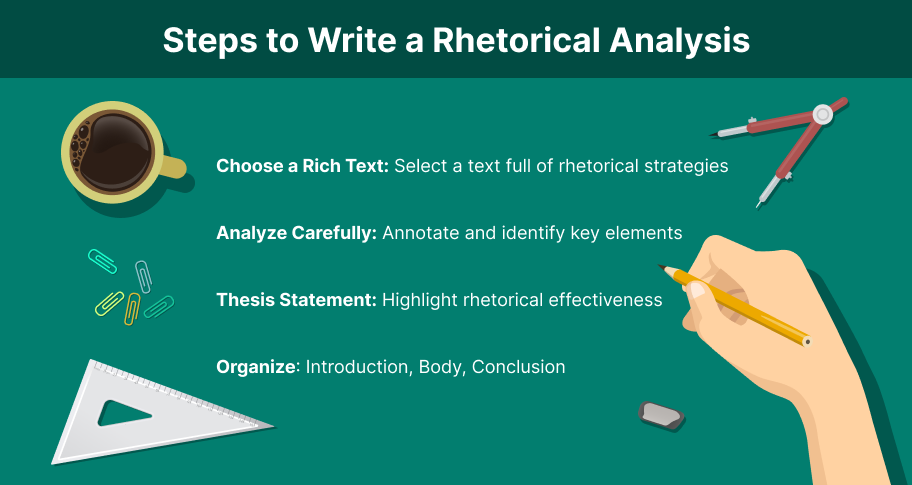
Rhetorical Analysis Essay Example
Title: The Persuasive Power of Martin Luther King Jr.’s “I Have a Dream” Speech
Introduction: Martin Luther King Jr.’s “I Have a Dream” speech, delivered during the 1963 March on Washington, is a seminal text in American history. King’s masterful use of rhetorical strategies has cemented this speech as a powerful tool in the civil rights movement. This essay analyzes how King employs ethos, pathos, and logos to persuade his audience of the necessity for racial equality and justice.
Body:
Ethos: King establishes credibility through his role as a prominent civil rights leader and his deep moral authority. His reputation and commitment to nonviolent protest lend weight to his message. By referencing the founding documents of the United States, King aligns himself with the nation’s values, enhancing his ethical appeal. His position as a minister also adds to his moral credibility, allowing him to speak with conviction and integrity.
Pathos: King effectively uses emotional appeals to connect with his audience. His vivid imagery and evocative language, such as “a dream deeply rooted in the American dream,” evoke strong feelings of hope and urgency. By sharing personal stories and invoking the suffering of African Americans, he generates empathy and mobilizes his audience to support the cause of racial justice.
Logos: King’s logical arguments are grounded in historical and legal references. He cites the Declaration of Independence and the Constitution to demonstrate that racial inequality is contrary to American principles. His structured arguments and clear examples of injustices provide a rational basis for his call for change, reinforcing his credibility and appealing to the audience’s sense of justice.
Conclusion: Martin Luther King Jr.’s “I Have a Dream” speech exemplifies the effective use of rhetorical strategies to inspire and persuade. Through his establishment of credibility, emotional appeals, and logical arguments, King crafts a compelling message that resonates with his audience and galvanizes support for the civil rights movement. His use of ethos, pathos, and logos ensures the speech’s enduring impact and relevance.
Analysis of Key Elements
1. Ethos:
- Establishment of Credibility: The essay highlights King’s role and reputation, showing how his credibility as a leader enhances his persuasive power.
- Moral Authority: Mentioning King’s background as a minister adds to his ethical appeal, making his arguments more persuasive.
2. Pathos:
- Emotional Appeals: The analysis identifies how King uses evocative language and imagery to stir emotions and build a connection with the audience.
- Personal Stories: By pointing out King’s use of personal and historical suffering, the essay demonstrates how pathos can engage the audience’s empathy and support.
3. Logos:
- Logical Arguments: The essay notes King’s use of historical and legal references to build a rational case for civil rights.
- Structured Arguments: It highlights how clear, reasoned arguments support King’s call for change, appealing to the audience’s sense of justice and rationality.
4. Overall Analysis:
- Integration of Rhetorical Strategies: The essay effectively integrates the analysis of ethos, pathos, and logos, showing how each element contributes to the speech’s persuasive power.
- Impact and Relevance: By discussing the speech’s enduring impact, the analysis reinforces the effectiveness of King’s rhetorical strategies in achieving his goals.
This example illustrates how a rhetorical analysis essay can dissect a text’s components to understand and explain its effectiveness in persuasion.
Tips for Writing an Effective Rhetorical Analysis Essay
- Avoid summarizing the text; focus on analyzing its rhetorical elements.
- Use clear and concise language.
- Support your analysis with evidence from the text.
- Be objective and avoid personal bias.
- Proofread carefully before submitting.
Conclusion
In this article, we have covered the basics of rhetoric, covered the steps to writing a rhetorical essay, provided the form of an outline, provided an example essay, and provided tips to writers. However, nothing teaches someone how to analyze rhetoric like actually doing it. If you are working on rhetorical analysis, practice with different texts. You can find examples online or use our tools to see if your analysis matches what other readers and writers have noted.
Ready to start your essay? Download our Rhetorical Analysis Essay Worksheet for free.
If you found this article insightful and valuable, why not share it with your friends and followers on social media? Your support helps spread important information and spark meaningful discussions. We’d also love to hear from you! Leave a comment below or ask any questions you might have—we’re here to engage and provide answers. Let’s continue the conversation and connect with others who might benefit from this content!
Here are some resources that can help with writing rhetorical analysis essays:
Books
“Everything’s an Argument” by Andrea A. Lunsford, John J. Ruszkiewicz, and Keith Walters
Offers an introduction to rhetorical analysis and the elements of effective argumentation.
“The Rhetorical Situation” by Lloyd Bitzer
Explores the concept of the rhetorical situation and its components.
“Rhetorical Analysis: A Brief Guide for Writers” by Philip K. Jason
Provides an overview of how to analyze rhetorical texts and write about them effectively.
Online Resources
Purdue OWL: Rhetorical Analysis
The Purdue Online Writing Lab offers comprehensive guidelines on writing rhetorical analysis essays, including strategies for analyzing texts and constructing arguments.
University of North Carolina at Chapel Hill Writing Center: Rhetorical Analysis
Provides practical advice on conducting a rhetorical analysis and includes examples and tips for structuring the essay.
Harvard College Writing Center: Rhetorical Strategies
This resource offers insights into different rhetorical strategies and how they can be used in analysis.
Academic Journals and Articles
“Rhetoric Review”
A journal that features scholarly articles on various aspects of rhetorical theory and practice, including rhetorical analysis.
“The Quarterly Journal of Speech”
Offers articles and research on rhetorical theory and practice, providing insights into rhetorical analysis techniques.
Google Scholar
Search for academic articles and papers on rhetorical analysis to find studies and examples relevant to writing your essays.
These resources should provide a solid foundation for understanding and writing rhetorical analysis essays, offering guidance on everything from basic concepts to advanced analytical techniques.

